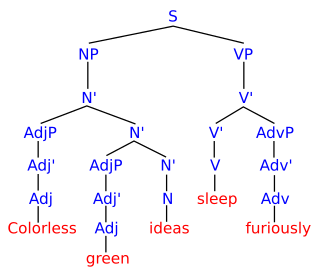
Edward Estlin "E. E." Cummings, often styled as e e cummings, as he is attributed in many of his published works, was an American poet, painter, essayist, author, and playwright. He wrote approximately 2,900 poems, two autobiographical novels, four plays, and several essays. He is often regarded as one of the most important American poets of the 20th century. Cummings is associated with modernist free-form poetry. Much of his work has idiosyncratic syntax and uses lower case spellings for poetic expression.

In mathematics, computer science, and linguistics, a formal language consists of words whose letters are taken from an alphabet and are well-formed according to a specific set of rules.
In logic, equivocation is an informal fallacy resulting from the use of a particular word/expression in multiple senses within an argument.
In linguistics, syntax is the set of rules, principles, and processes that govern the structure of sentences in a given language, usually including word order. The term syntax is also used to refer to the study of such principles and processes. The goal of many syntacticians is to discover the syntactic rules common to all languages.

An idiom is a phrase or expression that typically presents a figurative, non-literal meaning attached to the phrase; but some phrases become figurative idioms while retaining the literal meaning of the phrase. Categorized as formulaic language, an idiom's figurative meaning is different from the literal meaning. Idioms occur frequently in all languages; in English alone there are an estimated twenty-five thousand idiomatic expressions.
Poetry analysis is the process of investigating a poem's form, content, structural semiotics and history in an informed way, with the aim of heightening one's own and others' understanding and appreciation of the work.
In computer science, a syntax error is an error in the syntax of a sequence of characters or tokens that is intended to be written in compile-time. A program will not compile until all syntax errors are corrected. For interpreted languages, however, a syntax error may be detected during program execution, and an interpreter's error messages might not differentiate syntax errors from errors of other kinds.
Parsing, syntax analysis, or syntactic analysis is the process of analyzing a string of symbols, either in natural language, computer languages or data structures, conforming to the rules of a formal grammar. The term parsing comes from Latin pars (orationis), meaning part.
In logic and linguistics, a metalanguage is a language used to describe another language, often called the object language. Expressions in a metalanguage are often distinguished from those in the object language by the use of italics, quotation marks, or writing on a separate line. The structure of sentences and phrases in a metalanguage can be described by a metasyntax.
Dependency grammar (DG) is a class of modern grammatical theories that are all based on the dependency relation and that can be traced back primarily to the work of Lucien Tesnière. Dependency is the notion that linguistic units, e.g. words, are connected to each other by directed links. The (finite) verb is taken to be the structural center of clause structure. All other syntactic units (words) are either directly or indirectly connected to the verb in terms of the directed links, which are called dependencies. DGs are distinct from phrase structure grammars, since DGs lack phrasal nodes, although they acknowledge phrases. A dependency structure is determined by the relation between a word and its dependents. Dependency structures are flatter than phrase structures in part because they lack a finite verb phrase constituent, and they are thus well suited for the analysis of languages with free word order, such as Czech or Warlpiri.
The term phrase structure grammar was originally introduced by Noam Chomsky as the term for grammar studied previously by Emil Post and Axel Thue. Some authors, however, reserve the term for more restricted grammars in the Chomsky hierarchy: context-sensitive grammars or context-free grammars. In a broader sense, phrase structure grammars are also known as constituency grammars. The defining trait of phrase structure grammars is thus their adherence to the constituency relation, as opposed to the dependency relation of dependency grammars.
In linguistics, valency or valence is the number and type of arguments controlled by a predicate, content verbs being typical predicates. Valency is related, though not identical, to subcategorization and transitivity, which count only object arguments – valency counts all arguments, including the subject. The linguistic meaning of valency derives from the definition of valency in chemistry. The valency metaphor appeared first in linguistics in Charles Sanders Peirce's essay "The Logic of Relatives" in 1897, and it then surfaced in the works of a number of linguists decades later in the late 1940s and 1950s. Lucien Tesnière is credited most with having established the valency concept in linguistics. A major authority on the valency of the English verbs is Allerton (1982), who made the important distinction between semantic and syntactic valency.

Lucien Tesnière was a prominent and influential French linguist. He was born in Mont-Saint-Aignan on May 13, 1893. As a maître de conférences in Strasbourg (1924), and later professor in Montpellier (1937), he published many papers and books on Slavic languages. However, his importance in the history of linguistics is based mainly on his development of an approach to the syntax of natural languages that would become known as dependency grammar. He presented his theory in his book Éléments de syntaxe structurale, published posthumously in 1959. In the book he proposes a sophisticated formalization of syntactic structures, supported by many examples from a diversity of languages. Tesnière died in Montpellier on December 6, 1954.

In computer science, the syntax of a computer language is the set of rules that defines the combinations of symbols that are considered to be correctly structured statements or expressions in that language. This applies both to programming languages, where the document represents source code, and to markup languages, where the document represents data.

Sonnet 146, which William Shakespeare addresses to his soul, his "sinful earth", is a pleading appeal to himself to value inner qualities and satisfaction rather than outward appearance.
In linguistics, an argument is an expression that helps complete the meaning of a predicate, the latter referring in this context to a main verb and its auxiliaries. In this regard, the complement is a closely related concept. Most predicates take one, two, or three arguments. A predicate and its arguments form a predicate-argument structure. The discussion of predicates and arguments is associated most with (content) verbs and noun phrases (NPs), although other syntactic categories can also be construed as predicates and as arguments. Arguments must be distinguished from adjuncts. While a predicate needs its arguments to complete its meaning, the adjuncts that appear with a predicate are optional; they are not necessary to complete the meaning of the predicate. Most theories of syntax and semantics acknowledge arguments and adjuncts, although the terminology varies, and the distinction is generally believed to exist in all languages. Dependency grammars sometimes call arguments actants, following Tesnière (1959).

Shakespeare's Sonnet 33 is one of 154 sonnets written by the English playwright and poet William Shakespeare. It is a member of the Fair Youth sequence, in which the poet expresses his love towards a young man. This sonnet is the first of what are sometimes called the estrangement sonnets, numbers 33–36: poems concerned with the speaker's response to an unspecified "sensual fault" mentioned in (35) committed by his beloved.
Shakespeare's Sonnet 53, presumably addressed to the same young man as the other sonnets in the first part of the sequence, raises some of the most common themes of the sonnet: the sublime beauty of the beloved, the weight of tradition, and the nature and extent of art's power. As in Sonnet 20, the beloved's beauty is compared to both a man's (Adonis) and a woman's (Helen).

Sonnet 72 is one of 154 sonnets published by the English playwright and poet William Shakespeare in 1609. It is one of the Fair Youth Sequence, which includes Sonnet 1 through Sonnet 126.

Sonnet 110 is one of 154 sonnets written by the English playwright and poet William Shakespeare. Sonnet 110 was published along with the other sonnets in the 1609 Quarto. The sonnet falls in place with the Fair Youth sequence of Shakespeare's sonnets, in which the poet expresses his love towards a young man. The mystery of the young man is still unknown today. However, there are many different theories by various scholars of who this young man may be. There has been much debate whether or not this sonnet was written about Shakespeare's disdain with the stage and actors. Whereas others have interpreted sonnet 110 as the poet confessing his love to a young man.









